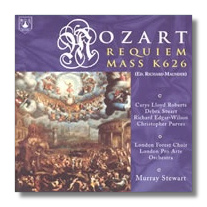
The Internet's Premier Classical Music Source
Related Links
- Mozart Reviews
- Latest Reviews
- More Reviews
-
By Composer
-
Collections
DVD & Blu-ray
Books
Concert Reviews
Articles/Interviews
Software
Audio
Search Amazon
Recommended Links
Site News
 CD Review
CD Review
Wolfgang Mozart

Requiem Mass, K. 626
Edited by Richard Maunder
Carys Lloyd Roberts, soprano
Debra Stuart, mezzo-soprano
Richard Edgar-Wilson, tenor
Christopher Purves, bass
London Forest Choir
London Pro Arte Orchestra/Murray Stewart
Merlin Edition MRFD95904
Summary for the busy executive: Nice interpretation; weak chorus and soloists.
Has Süssmayer become the Rodney Dangerfield of music? Instead of gratitude, critics and scholars have heaped coals of fire on his head for his completion of Mozart's Requiem. Also, so many have convinced themselves they would have done better. There are obvious voice-leading faults, which the Beyer edition, for one, has corrected, but Beyer also inflicted substantial changes in orchestration and, in some cases, even added phrases. All of these reconstructions, including Süssmayer's, have the same problems. First, great composers don't always repeat themselves. In fact, they often try something new. Most editors rely on a kind of statistical probability: "Mozart worked this way in that piece; therefore, he likely worked the same way in this one." Second, modern editors, at least, work in a style not really their own. Music has changed somewhat since Mozart's time. Furthermore, often the reconstruction boils down to "I don't like this; therefore Mozart (or Mahler) couldn't have written it. I'll replace it with something I do like instead." In a way, it's a touchingly sincere act of criticism. The apparatus of justification again comes down to an argument on probability.
All of this is compounded in the case of Requiem, since apparently Mozart's widow, Constanze, destroyed all of the composer's sketches. The facts that remain are these: Süssmayer is the only editor to have seen Mozart's score and to have actually discussed completion with the composer. He is the only editor who shared Mozart's general compositional style. As Mozart's pupil, he was taught that style by the composer. Everyone else plays powdered-wig dress-up. I agree with William Christie's approach (though I find the performance eccentric - Erato 0630-10697-2): Süssmayer is the closest we can come to the composer himself.
Richard Maunder substantially recomposes the "Lacrymosa" with phrases from the first movement changed to 12/8 time and tacks on an "Amen" double fugue, both of which, while admittedly more complex, sound no more and no less like Mozart than Süssmayer's versions do. Boys just want to have fun, too. There's also a truly lame brass chord to support the initial bass entry in the "Tuba mirum." One can see that Maunder got it from Sarastro's music in Die Zauberflöte, but other than to show he knows late Mozart, I fail to see what musical purpose it serves. After all, it's not as if Requiem bass soloists have exactly needed such support in the 200-plus years since Mozart. There are other places that Maunder has raised a hand to, but they're not nearly as annoying.
Murray Stewart strikes me as an outstanding Mozart non-Austrian interpreter. This is an incredible reading. He emphasizes the rhythmic crackle in Mozart's music and a sense of constant propulsion in the line. Too often conductors have played the Requiem with all the animation of liquid Prell, apparently suffering from the delusion that the work was really composed by César Franck. The orchestra follows him beautifully and the textures are fairly transparent. Given a group that can execute, there's a marvelous, caring, detailed examination of the score. For example, this is one of the few readings where the word "Osanna" is accented properly on the second syllable, rather than on the usual third. That's the good news. The bad news is that none of the vocal forces measure up to his reading. The choir seems to me an amateur group with fluttery tone and often mushy diction. Often, the sopranos don't quite make the high notes, as in the "Domine Jesu Christe" on the phrase "de poenis inferni." The soloists vocally are OK, but nothing special, although the bass is way too light for the part. His low notes on the "Tuba mirum" are so weak as to approach the inaudible.
The performance's main flaw comes down to rhythm. The choir almost always attacks behind the beat. This robs their entrance in the "Rex tremendae" of the electricity Mozart wrote in. The "Confutatis" is a notoriously difficult section for the choral men to keep to the pace, and the London Forest Choir predictably drag. However, the women fare even worse, at one point adding a 16th note to the measure. The soloists do no better. For some mysterious reason, they tend to slow down at the end of a phrase, as if they had no idea at all that the piece does indeed continue. In the "Domine Jesu Christe" at "sed signifer sanctus Michael," the soloists drag to such an extent that they add an 8th note to a measure. Both soloists and choir attack late and drag. Stewart is constantly having to pick up beats or wait for the performers to arrive where they should be. As good as the instrumentalists are, you can't keep contending with a quicksand of a choir and keep the pace or the precision of playing. I'd love to hear what Stewart would do with capable forces.
Copyright © 1997, Steve Schwartz












